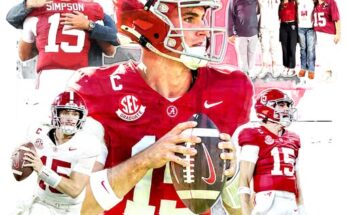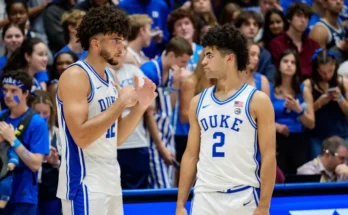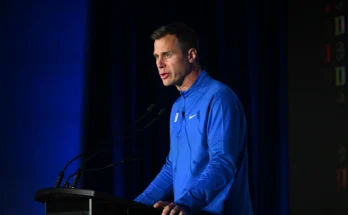Brandon Graham defends the Eagles’ potent Tush Push against detractors.
The Philadelphia Eagles have long been recognized for their aggressive, high-powered offense, but over the last few seasons, one particular play has stood out for both its effectiveness and the controversy it generates. The “Tush Push” – a play in which quarterback Jalen Hurts is assisted by his teammates, often including a powerful shove from a running back or offensive lineman, to convert short-yardage situations – has become a hallmark of the Eagles’ offensive strategy. However, while the Tush Push has proven incredibly successful, it has also drawn significant criticism from some circles. Despite this backlash, veteran defensive end Brandon Graham has become one of its staunchest defenders, touting the play as a legitimate and essential part of the Eagles’ offensive prowess. In this article, we’ll explore the origins of the Tush Push, its role in the Eagles’ offense, the criticisms it faces, and Graham’s defense of the play as an example of football’s evolving strategies.
The Rise of the Tush Push
While the Tush Push is often associated with the Eagles, particularly under head coach Nick Sirianni and offensive coordinator Shane Steichen, it has roots in traditional short-yardage plays that date back decades in the NFL. The key to the Tush Push is the use of a quarterback sneak, but with an added wrinkle: the quarterback, typically Hurts, is pushed from behind by a teammate, usually a running back or offensive lineman, helping him surge forward even when the defense has stacked the line of scrimmage. This variation of the quarterback sneak is often used in situations where the offense needs just a few inches or a yard to convert a critical first down or touchdown.
While it might sound simple, the execution of the Tush Push requires precise timing, powerful blocking, and a quarterback with both strength and short-area agility. The play became particularly effective when Hurts, known for his lower-body strength and ability to fight through tackles, added his unique skillset to the equation. Since then, the Eagles have made the Tush Push a staple of their offensive playbook, often using it to convert on third-and-short or fourth-and-inches situations with remarkable efficiency.
In fact, the success rate of the Tush Push in the 2022 and 2023 seasons was staggering. During the 2022 season alone, the Eagles converted an overwhelming majority of their attempts, with Hurts leading the charge and regularly converting on critical downs. This success continued into the 2023 season, making the Tush Push a key element of the Eagles’ offensive identity.
The Debate: Is the Tush Push Unfair?
Despite its undeniable success, the Tush Push has faced significant scrutiny from opponents, analysts, and fans alike. Many detractors have voiced concerns that the play is essentially an unearned advantage, arguing that the added assistance from teammates in pushing the quarterback goes against the spirit of football, where individual performance is paramount. These critics claim that the play is too easy to execute, especially when the quarterback, such as Hurts, is as physically capable as he is, and they contend that it turns a short-yardage situation into a nearly automatic conversion, rendering the defense’s efforts moot.
Some critics have also compared the Tush Push to other controversial strategies that have become more prevalent in modern football. For instance, the emphasis on passing and wide-open offenses has led some purists to argue that the resurgence of physicality, as seen in the Tush Push, undermines the delicate balance between passing and running in the modern game. Others simply take issue with the play’s perceived predictability, arguing that it takes away from the unpredictability that often defines exciting moments in football.
One of the most vocal groups opposing the play is a segment of the media and former players who feel that the Tush Push is too reliant on brute strength and doesn’t showcase the traditional skill sets required for success in the NFL. While many plays in football require a combination of speed, agility, and intelligence, the Tush Push is often seen as a less skillful tactic, relying primarily on the strength and power of the quarterback and his blockers.
Brandon Graham’s Defense
Enter Brandon Graham. As a leader on the Eagles’ defense, Graham has become a vocal defender of the Tush Push and its place in the modern NFL. In a league that often champions innovation, Graham sees the play as simply another example of teams adapting their strategies to take advantage of unique skill sets and new trends in the game.
“I don’t see the problem with it,” Graham said in a recent interview. “Every team has its thing. Some teams rely on their passing game, some rely on their defense, and we’ve got this short-yardage thing figured out. We’ve got a quarterback who’s strong and knows how to make the play, and we’ve got the line and backs to help him out. That’s what makes it work.”
For Graham, the Tush Push is not a gimmick or a cheap trick but a legitimate football play. He argues that the defense knows exactly what’s coming when the Eagles line up for the Tush Push – it’s not a surprise. The defense has the opportunity to stop it, but it’s not always possible because of the sheer strength, determination, and teamwork the Eagles bring to the table. In Graham’s view, football is about finding an advantage, and the Tush Push simply takes advantage of the Eagles’ physicality in key moments.
“Look, when it comes down to it, football is about execution. If you’re on defense, you’ve got to stop it. We know it’s coming, and we still have to find a way to stop it. It’s not like we’ve been caught off guard or anything. It’s a good play, and we’ve worked hard on it. That’s how football works – you find what works for you, and you go with it.”
In a sport where innovation often drives success, Graham sees the Tush Push as a natural evolution of the game. Teams are constantly searching for ways to gain advantages in various situations, and the Eagles have simply found a formula that works. To Graham, the play is a testament to the strength of the Eagles’ offensive line, Hurts’ abilities as a quarterback, and the offensive coaching staff’s commitment to finding new ways to win.
Graham also points out that the Tush Push isn’t invincible. There are times when the defense can and does stop the play. Whether it’s a penetration by the defensive line, a well-timed hit on the quarterback, or a strategic adjustment by the defense, the play is not a guaranteed success. However, Graham insists that the success rate speaks for itself – the Eagles’ offensive line and Hurts’ leadership make the Tush Push difficult to stop.
“It’s not like every team can just do it,” Graham said. “You need the right personnel. You need a strong offensive line, a tough quarterback, and backs who know how to help him out. We’ve got that, and it works for us.”
The Future of the Tush Push
As the Tush Push continues to dominate discussions in the NFL, one of the questions that remain is whether the league will take action to outlaw the play. The NFL has often adjusted its rules to balance the competitiveness of the game and ensure fair play. The Tush Push could be on the radar for rule changes in the future, especially if it continues to gain popularity and dominance in short-yardage situations.
However, for now, it appears that the play is here to stay. As Graham points out, the Eagles’ success is not just about the Tush Push itself but about the broader philosophy of adapting to the changing landscape of the game. The Eagles have found a way to execute this play with incredible precision, and it’s hard to argue with results. Whether or not it becomes a permanent fixture in NFL offenses remains to be seen, but for now, the Eagles are happy to keep using it to their advantage.
The Tush Push has sparked both admiration and controversy in the NFL. While some critics argue that it’s too easy and undermines the spirit of the game, others, like Brandon Graham, defend it as a legitimate football strategy that takes advantage of the unique strengths of the Eagles’ players. Whether it’s the power of Jalen Hurts or the strength of the offensive line, the Tush Push has become an iconic part of the Eagles’ offensive identity. As long as it continues to succeed, Graham and his teammates will likely continue to embrace it – and defend it – as one of the most effective plays in modern football.
For now, the Tush Push remains a symbol of the Eagles’ ability to adapt and execute under pressure, a testament to their physicality and determination. And for Brandon Graham, it’s just another way that football, like any sport, continues to evolve.



